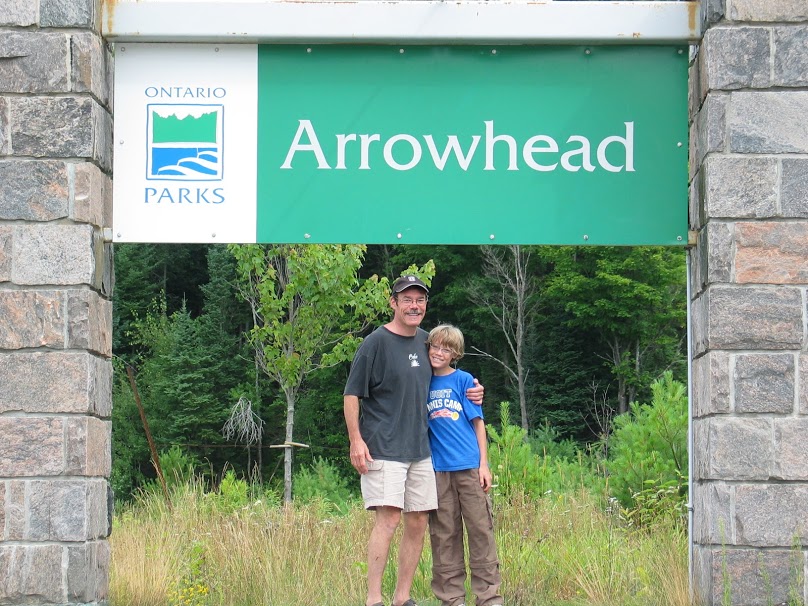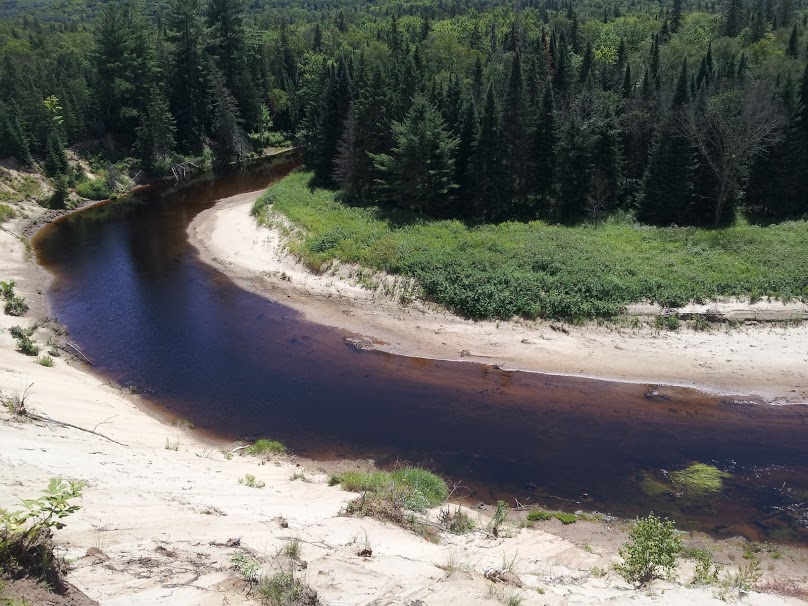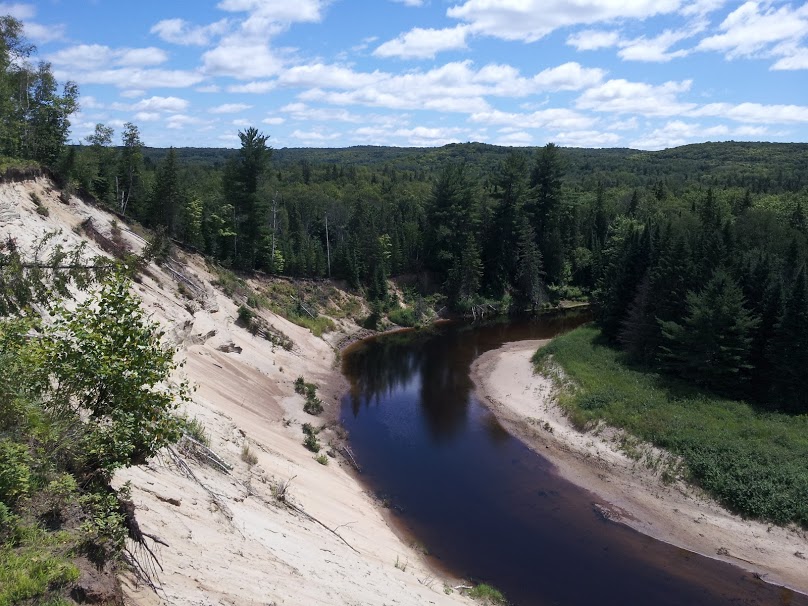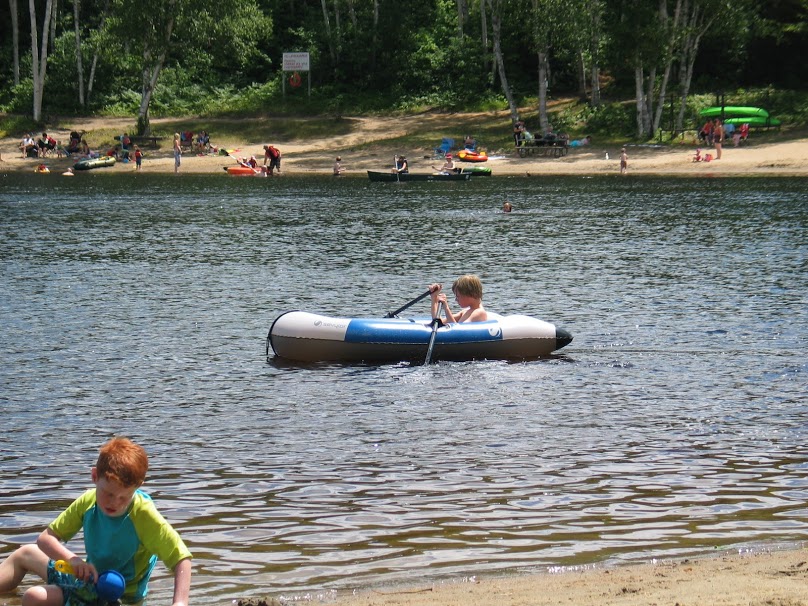
Pamela: Hello and good day. Welcome to the Super Good Camping Podcast. This is our third episode. I’m Pamela
Tim: and I’m Tim.
Pamela: And we wanted to talk about a couple of things today. We wanted to revisit choosing the perfect campsite, there’s a couple of things that we should have mentioned last time that we neglected to so we’ll add to that today. We also wanted to get into choosing a campground. So sit back, relax, have your favorite warm beverage and we’ll get going.
Choosing the Perfect Campsite

So as far as choosing a favorite campsite, one of the things that we didn’t mention last time is electric vs. non-electric. What do you think, Tim as far as choosing that, pros and cons?
Tim: For my money, we generally choose non-electric sites. We have battery operated lights for, you know, evening sort of stuff, everything else runs on propane. We don’t need to hook into anything.
Pamela: We have solar chargers as well.
Tim: We are tree huggers.
Pamela: But we’re dependent on sunshine for that, which doesn’t always cooperate.
Tim: Correct. Although, we do have power banks, so we charge them and hopefully get through a few days of running any devices or charging or recharging cameras or anything like that. The biggest difference that I’ve found between electric or non-electric is, being that we tent camp, we tend to not have a big RV right beside us with their air conditioning running. Don’t misunderstand, to each their own, it’s just not my style of camping. So I’m looking for, sort of, a quieter area. which we’ve discussed before. So there are my thoughts on electric vs. non. Obviously, if you’ve got an RV or even a pop-up trailer, it’s a little dark inside, you’re running off a 12-volt battery that maybe you forgot to charge before you showed up, or what have you, you don’t want to be running a generator so maybe an electric site is the right choice for you there. Or as you’re headed towards winter, if you’re going to be a little cool and you’re going to run an electric heater, something like that, there’s a good reason to have an electric site. But be safe with that electric heater in your tent, please.
Pamela: While we try to be disconnected from our devices while we’re away camping, one of us is a little bit dependent on staying on top of the emails. Otherwise, by the time we get back, there’s going to be a week’s worth of email that I can’t possibly catch up on. So anyway, I do tend to try to stay on top of my emails once or twice per day, even while we’re away and I usually do that on my phone. So, that’s our electric vs non-electric critique. Radio-free is something that we also often gravitate towards, for similar reasons – we like the quiet, we don’t want to listen to someone else’s music.
Tim: Which we’ve also discussed.
Pamela: And site size was something that we didn’t touch on either. We have a preference for the size of site that we need for tents. So we’ll have typically two tents. One for us and one for the kids. We’ve had a really large tent at some point where we all slept in a really large tent, but then we broke it up into smaller tents as the kids wanted a bit more privacy.
Tim: The privacy is in your head, because it’s a very thin piece of nylon between you and them. There’s no privacy.
Pamela: And then, as far as choosing your site, you might be set on one that you absolutely love and think it’s the perfect one. But we usually recommend that you have several as back-up options just in case you can’t get your ideal site, you at least have a few other options chosen so that you’re not wasting time at the time that you can book the site trying to find another one.
Tim: Yeah, so you’re definitely going to run into it at some point where you’ve chosen the perfect site and when you go to book it, someone has done that 5 month and 23 day loophole and your site is gone. Particularly with the more popular parks and within each park often a particular campground is more popular with a particular type of camper. Maybe it’s a tent camper or you’ll walk through some or bike through some campgrounds when you’re camping and find that they’re just chock full of the larger motor homes and RV’s because they’re designed to be easier to back in to or to drive through with an RV. They’re all electric sites. They’re closer to the dumping stations, etc., etc. Me personally, I’m a bit of a whack job. I pick about 6 sites as a general rule as backups, or at least 5. I pick our ideal site and then I start ranking another 5, so we’re not left high and dry when it comes time to go to book it. Seven o’clock in the morning 5 months ahead of time you’d be surprised at how quickly you’ll look at it and go “oh great” my ideal site is still available, and then you’ll go and just double-check another site that may be better and you’ll come back and you’re first site is gone. It is that fast.
Pamela: We use information from the Provincial Park’s own website. Tim also has a couple of other resources that he’ll look at in terms of trying to look at pictures of the different sites.
Tim: Right, at some point we should do a full list of my favourite bookmarks for picking sites. I don’t have it in front of me at the moment. There is one site, I believe it’s called Campsite Pictures. It is a paysite. It is $5 per year and totally worth it. It doesn’t have every Ontario park, but it has the majority of them, it absolutely has all the popular ones. And it gives you just another perspective, another go at different angles on the site. Because it’s a picture, it’s 2-dimensional, it’s not always easy to see exactly all the things that you are looking for. Obviously, as I said before, I follow a boatload of Facebook groups that are searchable. So you can get people’s perspectives on things, their, sort of, rating of any given campground and/or site. And there are some groups on Facebook, as well, that do pictures for each park. Often quite a few sites in the park themselves. They’re all in folders within that group. They’re pretty awesome.
Choosing the Best Campground or Provincial Park
Pamela: So, let’s move on. We’ll talk about choosing a campground or Provincial Park. So there are some things that we would like to look into, as far as what features we are looking for when we are choosing a particular park to go to. The landscape for example is something that you might want to consider. Like if you definitely love to hang out on the beach, that’s going to be your main activity for the time that you’re there, then you want a particularly good beach. And you might want to be at a lake where you can go canoeing or kayaking, where you can do some fishing. You might want to have a river where you can do some river kayaking. Granite outcroppings are always quite beautiful in terms of just the natural landscape. At Arrowhead, which we’ll get to, one of the places where we used to go swimming had these beautiful granite rocks. So you’d swim and you’d get kind of cooled off and then you could lie out on the granite rocks which were nicely warmed by the sun and get warmed back up again. It was quite lovely there. As far as landscape any other comments Tim?
Tim: Well along the lines of swimming Arrowhead Lake was also great. Arrowhead Lake has got a fabulous beach but one of the things that I quite liked about it is that it’s a very shallow entry into the water. You could go quite a ways out and the kids would only be up to their waists in water. Since ours were a little smaller back then (they aren’t now), that was an important thing. You didn’t have to be right on top of them. They could have some independent playtime, catch frogs, fish, whatever. There was safety. They could play around in the boat, you didn’t have to worry about them falling out and into 6 feet of water, not be able to touch bottom, that sort of deal.
Pamela: And the distance from home was a factor for us too, especially when the kids were younger. To have them entertained in the car for 6 hours driving somewhere really was not something that we really wanted to do. So that’s why our first park was Sibbald because it was close to home. But we’ve gradually extended our distance as far as how far away we are willing to drive. Last summer we went to Killarney Provincial Park which was a 5 or 6-hour drive. But earlier on we tried to aim for ones that were an hour to two hours from home. And dog-friendly because we’ve had a dog for as long as we’ve been camping together so we wanted a dog beach or at least a park where the dogs would have an exercise area where they could roam somewhat freely and get some exercise and not be constantly on the leash. We like to hike and we always bring our bikes with us when we go camping. We always like to have places where we can do both. And swimming is something that we will do as well. The kids love to spend time in the water. And fishing is something that we have done. Some of the parks too are also open year-round, so that you can also partake in winter activities. And that’s one of the features of Arrowhead Provincial Park as well. They have cross country skiing, they have a famous skating trail that is a 1.3 km trail where you can weave through the woods. and they have tubing and snow-shoeing. As far as Arrowhead is concerned those are some of the activities that you can do in the wintertime as well as all the summer activities.
Tim: Yes, and the trail is also, I don’t know that it is every night, but I know that some nights they have tiki torches along the trail and they light them up. That’s something that is on my bucket list to do. It looks very, very cool. Combined with that, they also have 10 cabins that you can rent by the night. I’m sure you want to be booking them, oops not now, but in July. You know, you can do your skating, your night skate, and then go enjoy some hot chocolate and stay overnight in the winter and then do some snowshoeing in the morning before you head out.
Pamela: As a country girl that grew up in a small town and on a farm, our creek used to freeze over in the wintertime and you could go skating on it. I remember one night in particular, as a child, that we went out skating on a moonlit night. It was just magical so I can imagine going to Arrowhead and doing the same at night. There would be the same kind of feeling, just a beautiful moonlit night with snow all around and you’re just weaving through the woods on your skates.
Arrowhead Provincial Park
That will lead us nicely into Arrowhead Provincial Park. Which was our third park camping together as a family. Some of the things that we loved about Arrowhead, Tim mentioned just briefly, Stubb’s Falls. We were fortunate enough, and this was quite by accident, that our campsite was quite close to one of the natural features in Arrowhead which is Stubb’s Falls. It is a small little waterfall that is over granite rocks. It falls down into a little pond kind of area at the bottom that you could swim in. We strapped the kids into their lifejackets and went into the bottom of Stubb’s Falls. It was like almost being in a natural hot tub with water kind of bubbling all around you. It wasn’t hot, but it was very foamy water. So we puddled around the bottom of the falls which was fun. The kids LOVED it. In their lifejackets, the force of the water coming down the falls would push them away. So they would be floating away from the bottom of the falls.

Tim: It was tons of fun! The kids, we couldn’t get them out of the falls. We spent more time there than doing anything else that year. It’s nice, you know, the sound of the falls and whatnot, if there is any traffic on the road, which is not that far from there, you can see it but you can’t hear it.
Pamela: Just one word of caution. It is a dangerous place as well. We witnessed that first hand. We were at the bottom of the falls puddling around and a young girl slipped up above in the falls and she fell down the falls to where I was at the bottom. Where I grabbed her and I handed her over to Tim who then handed her over to her parents. Fortunately, she wasn’t seriously injured, she was frightened but not seriously injured.
Tim: Not as frightened as we were watching her come towards us!
Pamela: Right, we were so afraid that she was going to hit her head on the way down, which thankfully she didn’t. She remained conscious but just frightened. But anyway we saw that firsthand and in subsequent years, someone, unfortunately, died in Stubb’s Falls. I assume that it was some similar circumstance where perhaps they fell in. The rocks up above are quite slippery when they are wet and unexpectedly so. We certainly felt that ourselves but we were fortunate enough not to have actually fallen in. Just be aware if you are anywhere near there, I would stay away from the upper part of the falls where the rocks are wet, because you could easily slip and fall in and have a serious injury as a result.
Tim: Unless you are a big fan of wearing water shoes because they would be grippier than your bare wet feet. Absolutely use caution when you are walking your way down.
Big Bend Lookout

Pamela: One of the other very beautiful things about Arrowhead is the Big Bend Lookout which is on one of the trails. So you hike the trail and you get to this viewing platform where you can look out over Big Bend. Which is a big curve in the East River that passes through Arrowhead. The interesting thing about the Big Bend is that its part of a process where the river curves to such an extent that it actually erodes away at the outer part of the curve. This pulls some of that soil further down the river and actually blocks itself off. As it blocks itself off it becomes something known as an Oxbow lake. It’s just a curved lake that has formed as a result of the curve of the river and the river has actually cut itself off and made itself into a little lake.

Tim: This particular one flows in from Algonquin Park, I believe it’s about a foot a year that it erodes the outer bank. There’s a large platform with a nice plaque on it to look at the Oxbow lake which is quite cool. Just because it’s very distinct and because, me personally, I’ve never seen anything like that before. But they have to move it back by a foot every year because the bank is disappearing underneath it. I think they said it was about 20 feet over the last 20 years that they’ve had to move it back.

Pamela: As Tim mentioned Arrowhead lake was where we spent another beautiful day with the kids. We had this little inflatable boat, so they would go out and just muck around in it. Push each other out and topple it over, but they would be fine because the water was shallow enough that there was no concern about anybody.
Tim: It’s like 2 feet, 2.5 feet deep.
Pamela: You can also rent canoes, and kayaks, and paddleboats at Arrowhead. So if you don’t have those things yourself but you’d really love to enjoy the lake, you can rent them while you’re at the park. People would canoe up to the top of Stubb’s Falls which was a nice little paddle. You could get out and moor your canoe and then wander around and check out the falls. We also were fortunate enough to see a moose when we were at Arrowhead.

Tim: We did too. I have pictures of our eldest with the moose in the background. I think we saw the moose twice off the top of my head because we were hiking once and we were biking once. I can’t tell you how majestic a creature a moose is, that’s so cool, man. We weren’t very far away from our campsite either, maybe a 5-minute bike ride from our campsite when we saw it. Holy mackerel!
Pamela: We’re proud Canadians and we’re proud of our moose.
Tim: We’re proud of our moose and we drink maple syrup once per week.
Pamela: I think that’s it for us, unless you had any other comments about Arrowhead or shall we regroup and go back?
Choosing a Campsite
The things to consider when choosing the perfect campsite:
- electric vs non-electric
- do you want to be in the radio-free section which may be a little bit quieter
- you want to choose your site based on the size of your accommodations, so do you have a tent, do you have a trailer and
- choose several options just in case your ideal site has been taken.
Check out last week’s post for more tips to choose a great campsite.
Choosing a Campground or Provincial Park
As far as choosing a campground or Provincial Park:
- consider the landscape
- how far you are willing to travel
- is it dog-friendly if you are bringing a dog with you
- what activities would you like to partake of while you are there, do you want to go hiking, biking, fishing, or swimming
- do you want to rent equipment like a canoe or a kayak
- did you want to go in the summer, did you want to go in the winter.
Tim: Just in case we didn’t explain well enough about dog-friendly, you are looking for things like having a specific dog beach or at least a beach where dogs aren’t banned because that is often the case or at the very least you want an exercise area. There’s often a sort of grassy area set aside for dogs to run around because they need to do that sort of stuff.
Pamela: Right, and otherwise the regulations are that dogs have to be kept on a leash at all times of no longer than 6 feet.
Tim: Yeah, 2 metres. Maybe just a side note about the hiking and the biking. There are a number of parks that have dedicated paths, sometimes they are multi-use, sometimes you can hike them and bike them. But there are also a number of them that are set aside specifically for either hiking or biking. Usually, if they are set aside for just one it’s for hiking. Most parks have well-paved roads where traffic is supposed to be moving at 20 km per hour, no more than 20 km per hour, that’s not necessarily the case all the time. But usually, those are quite good for biking around too. Sometimes you are going up to the park’s convenience store to pick up some wood or an ice cream.
Pamela: The kids do love that! That’s it for us today. I hope you have a wonderful rest of your Sunday If you would like to reach out to us our email address is hi@supergoodcamping.com, that’s “h” “i” at supergoodcamping.com. We would love to hear from you and if you have any questions or comments, please let us know. Thanks and have a wonderful day.
Tim: See ya!
Pamela: Bye!
